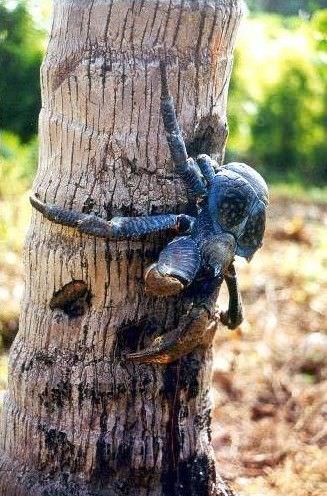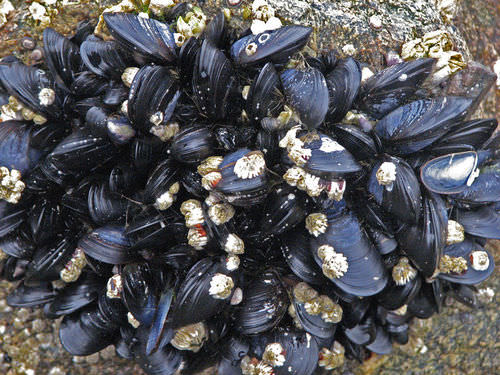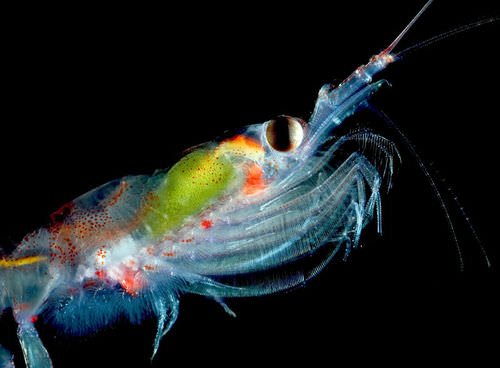15.34 甲壳 -- -- 高级
章节大纲
-
What do crabs, lobsters, crayfish, shrimp, krill, and barnacles have in common?
::螃蟹、龙虾、龙虾、龙虾、虾、虾、磷虾和谷仓有什么共同之处?These are all crustaceans, a very large crop of with about 67,000 described . They are distinguished, in part, by their biramous (two-parted) limbs.
::这些都是甲壳类动物,其产量很大,约有67 000人。 部分区别在于两肢两肢。Crustaceans
::结壳类There are roughly 40,000 species of crustaceans, and they are the predominant arthropods of the ocean. They include lobsters, shrimp, crabs, and barnacles. There are also some freshwater species, such as crayfish, and even a few species like sand fleas. Like myriapods and hexapods, crustaceans have modified feeding appendages called mandibles and maxillae. So what makes a crustacean different from other arthropods? The defining features of crustaceans are two pairs of antennae located in front of the mouth and a unique larval stage that is common to all members of this subphylum. These will be discussed in more detail later in this section.
::约有40,000种甲壳类动物,它们是海洋的主要节肢动物,包括龙虾、虾、螃蟹和谷仓。还有一些淡水物种,如龙虾、虾、螃蟹和谷仓。还有一些淡水物种,如龙虾、螃蟹,甚至少数物种,如沙蚤等。像甲壳类动物和六头动物一样,甲壳类动物改良了喂养附加物,称为甲壳类动物和最大类动物。为什么甲壳类动物与其他节肢动物不同?甲壳类动物的特征是两对天线,它们位于嘴前,是这一次植物所有成员共有的独特的幼虫阶段。本节稍后将更详细地讨论这些特征。Structure and Function
::结构和职能Crustaceans have three basic body regions: the head, thorax, and abdomen (although in many species the head and thorax have fused to form a cephalothorax). The head region has two pairs of antennae and three pairs of feeding appendages: a pair of mandibles and two pairs of maxillae. The crustacean head also contains two compound . These eyes may or may not be located at the end of stalk-like projections on the head. The appendages of most crustaceans are branched or biramous, with the exception of the first pair of antennae. The exoskeleton often includes a carapace, or a shield-like plate that covers the dorsal side of the cephalothorax region. This feature is shared with chelicerates. A diagram of the overall body plan of a typical crustacean, highlighting the carapace, is shown in Figure .
::甲壳类动物有3个基本身体区域:头部、胸部和腹部(尽管许多物种的头部和腹部已经结合成头部和腹部)。头部区域有两对天线和三对喂养附件:一对曼皮和两对马西利亚。甲壳类动物头部也包含2个化合物。这些眼睛可能位于头部的尾部,也可能不位于尾部的尾部。大多数甲壳类动物的附着物是分支或两栖的,但第1对天线除外。外骨类通常包括一块木薯,或覆盖头部区域圆顶部的盾牌。这个特征与乳腺共有。图中显示了典型的甲壳类动物总体计划图,突出了卡帕切。The external anatomy of a crustacean with the carapace highlighted in orange. In this example there are two main body regions, the cephalothorax and the abdomen. You can see from this diagram that, unlike chelicerates, crustaceans have appendages on the segments of their abdomens. You can also see the branching at the end of some of the biramous appendages. The internal organ systems of crustaceans are much like those of most arthropods. They have an open circulatory system and a centralized . Coxal glands carry out the process of excretion in crustaceans. Crustaceans respire by through the surface of their bodies (small species), with gills (most species), or, rarely, with very primitive lungs . An example of a terrestrial crustacean that respires using lungs is the coconut crab shown in Figure .
::甲壳动物的内部器官系统与大多数节肢动物的器官系统大相径庭。它们有一个开放的循环系统和中央系统。 甲壳类腺在甲壳类动物中进行排泄过程。 甲壳类动物通过它们身体的表面(小物种)、刺状物(大多数物种),或很少使用非常原始的肺。图中显示的是使用肺的悬浮的陆地甲状腺动物的椰蟹。A coconut crab is a terrestrial member of the class Crustacea that respires using primitive lungs. In the next section we will examine different modifications of these basic crustacean features that are found in some of the classes within the crustacean subphylum.
::在下一节中,我们将审查甲壳类亚植物中某些类别中发现的对这些基本甲壳类特征的不同修改。Classification
::分类分类分类分类分类分类分类分类分类分类分类分类分类分类分类分类分类分类分类分类分类分类分类分类分类分类分类分类分类分类分类分类分类分类分类分类分类分类分类分类分类分类分类分类分类分类分类分类分类分类分类分类分类分类分类分类分类分类分类分类分类分类分类分类分类分类分类分类分类分类分类分类分类分类分类分类分类分类分类分类分类分类分类分类分类分类分类分类分类分类分类分类分类分类分类分类分类分类分类分类分类分类分类分类分类分类分类分类分类分类分类分类分类分类分类分类分类分类分类分类分类分类分类分类分类分类分类分类分类分类分类分类分类分类分类分类分类分类分类分类分类分类分类分类分类分类分类分类分类分类分类分类分类分类分类分类分类分类分类分类分类分类分类分类分类分类分类分类分类分类分类分类分类分类分类分类分类分类分类分类分类分类分类分类分类分类分类分类分类分类分类分类分类分类分类分类分类分类分类分类分类分类分类分类分类分类分类分类分类分类分类分类分类分类分类分类分类分类分类分类分类分类分类分类分类分类分类分类分类分类分类分类分类分类分类分类分类分类分类分类分类分类分类分类分类分类分类分类分类分类分类分类分类分类分类分类分类分类分类分类分类分类分类分类分类分类分类分类分类分类分类分类分类分类分类分类分类分类分类分类分类分类分类分类分类分类分类分类分类分类分类分类分类分类分类分类分类分类分类分类分类分类分类分类分类分类分类分类分类分类分类分类分类分类分类分类分类分类分类分类分类分类分类分类分类分类分类分类分类分类分类分类分类分类分类分类分类分类分类分类分类Most living species of crustaceans fall into one of the following five classes:
::大多数甲壳类生物物种属于以下五类之一:-
Remipedia.
::雷米佩迪亚 -
Cephalocarida.
::切法洛卡里达 -
Branchiopoda.
::分会。 -
Maxillopoda (copepods, barnacles).
::Maxillopoda(科普普特、谷仓)。 -
Malacostraca (amphipods, decapods, krill).
::Malacostraca(印花、脱冠、磷虾)。
The differences between species of each class are primarily seen in their body forms; for example, the number of segments, the presence or absence of a carapace, and the shape and function of their appendages all vary between the classes. Remipedia, Cephalocarida, and Branchiopoda are all small classes, with roughly 12, 9, and 900 species respectively. The largest classes are Maxillopoda, with over 10,000 species, and Malacostraca, with over 20,000 species. In the next section we will consider some of the details of these two classes.
::每类物种之间的差别主要体现在其身体形式上;例如,各类的种类数量、是否存在或不存在卡拉帕切,以及其附属物的形状和功能各有不同。Remipedia、Cephalocarida和Brookiopoda都是小类,分别约有12、9和900种。最大的类别是马西西洛波达,有10,000多种物种,马拉科斯塔卡,有20,000多种物种。在下一节,我们将考虑这两个类别的一些细节。Maxillopoda and Malacostraca
::马克西洛波达和马拉科斯特拉卡A typical maxillopod has a head made up of five segments: a thorax consisting of six segments and an abdomen with four segments. There are no appendages on the abdomen. Copepods and barnacles make up the majority of the species in Maxillopoda. Copepods are tiny (most are about the size of a spec of dust) organisms found in all aquatic environments that are distinguished by having a single, simple eye. Copepods are abundant in number and are enormously important members of the . This is due to the fact that they consume large amounts of organisms that occupy the base of the aquatic food chain, such as phytoplankton (tiny, drifting plants), and in turn are a major source of food for organisms further up in the food chain. Copepods include filter feeders that consume other plankton, predators that feed on small prey such as insect larvae , and many symbiotic and parasitic species. The word copepod means “paddle foot,” and the appendages of copepods are modified for efficient swimming. Figure shows a copepod.
::典型的峰顶螺旋动物头部由五个部分组成:一个由六个部分组成的胸腔和一个有四个部分的腹部;腹部没有附着物;科波多和谷仓占了马克西洛波达大多数物种的多数;科波波多是所有水生环境中发现的极小的生物(大部分与尘土的大小差不多),这些生物有单一的简单眼睛;科波波特人数量丰富,是其中非常重要的成员。这是因为它们消费大量有机生物,占据水生食物链的底部,例如浮游植物(蒂类,漂浮植物),反过来是食物链中生物的主要食物来源。科波波多包括食用其他浮游生物的过滤器、食食食食昆虫等小猎物的捕食动物以及许多共生生物和寄生物种。该词是指“浮脚,”以及附在水中生长的附生生物,这些生物是高效的游泳图。A species of copepod within the class Maxillopoda of the subphylum Crustacea. Notice that there are no appendages on the abdomen. These tiny animals play a major role near the base of the aquatic food chain. Barnacles have a very different body plan and life style from most arthropods. On the surface, they look much more like than arthropods, as shown in Figure . However, they go through a specific larval stage during their that is a defining characteristic of crustaceans. You will learn more about this stage in the next section. Barnacles attach themselves to a solid substrate and live a sessile existence. Unlike most arthropods, they are usually hermaphrodites, meaning that an individual can generate both and eggs .
::如图所示,在表面,它们看起来比节肢动物更像。然而,它们经过一个特定的幼年阶段,这是甲壳类动物的特征。在下一节中,你会更多地了解这一阶段的情况。甲状腺动物与大多数节肢动物有着非常不同的身体图案和生活方式。与大多数节肢动物不同,它们通常都是草药,这意味着一个人既可以产卵,也可以产卵。A mass of barnacles surrounding a group of mussels. The barnacles are lightly colored, and the mussels are dark. Notice that the barnacles look like they might be more closely related to the mussels (mollusks) in this photograph than to spiders (arthropods), but the opposite is true. Malacostraca includes the species that most people think of when they hear the word crustacean. They include decapods (having 10 feet) such as lobsters, crabs and shrimp, amphipods, isopods, and krill. Species within these different orders vary primarily on the number and structure of their appendages. Isopods are the most diverse group, and they include a number of terrestrial species. Most Malacostraca have three body regions: a head of five segments fused to a thorax of eight segments and an abdomen of six segments. The overall body plan of a Malacostraca is shown in Figure .
::马拉科斯特拉卡(Malacostraca)包括大多数人们听到甲壳类这个词时所想到的物种,包括诸如龙虾、螃蟹和虾、两栖动物、等栖动物和磷虾等(10英尺长的)脱壳动物。这些不同种类的物种主要因其附种的数量和结构不同而不同。伊索波德是最多样化的物种组,它们包括一些陆地物种。大多数马拉科斯特拉卡有3个体体区域:一个有5个部分的头部,与8个部分的胸腔结合,一个有6个部分的腹部。图中显示了马拉科斯特拉卡的整体体图示。The external anatomy of a typical member of the crustacean class Malacostraca. Pereiopods function as walking legs, while pleopods are swimming legs. The uropods act as tail fins along with the telson. The rostrum is a ledge region at the front of the carapace that extends over the head to protect it. Notice the stalked eye tucked in under the rostrum. Another interesting feature that can be seen in this diagram is that the first antennae are biramous. This is distinct from most crustaceans, in which the first antennae are uniramous. Development and Ecology
::发展和发展生态学和发展Crustaceans reproduce sexually, and, in most species, male and females are separate sexes. Unlike the myriapods, development in crustaceans is considered indirect. That means that there are intermediate juvenile stages called larval stages that are very different in form from the adult. One of the unifying features of all crustaceans is that they all develop through a larval stage called nauplius (plural, nauplii ) that is unique to this group. A nauplius larva is shown in Figure . The defining feature of nauplii is that they use appendages attached to the head as swimming appendages. These appendages change considerably as they develop into the antennae of the adult crustacean. This is characteristic of indirect development; the transition from larvae to adults usually involves a fairly drastic change in form called metamorphosis . You will see in the Insect concepts that indirect development is also common for the of Hexapoda although they do not go through a nauplius larval stage.
::甲壳类动物在性方面繁殖,在大多数物种中,男性和女性是不同的性别。与甲壳类动物不同,甲壳类动物的发育被认为是间接的。这意味着有中等青少年阶段,称为幼年阶段,其形式与成年人大不相同。所有甲壳类动物的一个统一特征是,它们都通过这个群体独有的幼年阶段发展,称为nauplius(多元性,nauplius),在图中显示一个nauplius 幼虫。nauplii的界定特征是,它们使用头部附着的附附附作为游泳附附。这些附附附随着它们进入成年甲壳类动物的天线而发生相当大的变化。这是间接发展的特点;从幼虫向成人的过渡通常涉及一种被称为变形的相当剧烈的变化。从昆虫概念中可以看到,间接发展对于Hexapoda也是常见的,尽管它们没有经过nauplius 幼年阶段。A nauplius larva. This larval stage is unique to the subphylum Crustacea. Most crustaceans are free-living, but there are some sessile (unable to move from place to place) species such as the barnacles mentioned earlier. Crustaceans obtain food by , filter feeding, scavenging, or through parasitism . Members of the class Malacostraca are a major source of food for humans and are also an important part of the economy.
::大部分甲壳类动物是自由生存的,但有一些(无法从地方迁移到地方)的物种,如前面提到的谷仓。 甲壳类动物通过过滤、喂食、拾荒或寄生虫获得食物。 马拉科斯塔卡族成员是人类的主要食物来源,也是经济的重要组成部分。Many crustaceans, such as copepods and krill, are extremely important components of the food chain. Krill, like the one shown in Figure , are found in all oceans of the world where they constitute a large portion of the overall biomass . One particular species, the Antarctic Krill ( Euphausia superba ), compose a biomass of over 500 million tons, roughly twice that of humans. Like copepods, they are considered key species near the bottom of the food chain because they feed on phytoplankton and other tiny, drifting . Other organisms higher up in the food chain, such as whales, seals, penguins, and squid, rely on krill as a major food source and indirectly obtain the nutrients originally generated by phytoplankton through eating krill.
::许多甲壳类动物,如甲壳类动物和磷虾,是食物链中极为重要的组成部分。如图所示,磷虾在世界所有海洋中都发现,它们占生物量的很大一部分。一种特定物种,南极磷虾(Euphausia superba),构成5亿多吨的生物量,大约是人类的两倍。与甲壳类动物一样,它们被视为食物链底部的关键物种,因为它们食用浮游植物和其他微小的漂浮生物。食物链上方的其他生物,如鲸鱼、海豹、企鹅和鱿鱼,依赖磷虾作为主要食物来源,通过食用磷虾间接获取浮游植物最初产生的养分。A species of krill. A common theme in studying arthropods is their massive numbers – either number of species or number of individuals within a species. This holds true for krill as well. If all the individuals of all the krill species were gathered together, their mass would be well over twice the mass of all of the humans on Earth. It is sometimes difficult to fathom the vastness of the ocean and the importance of the many tiny species that inhabit the seas. Summary
::摘要-
There are roughly 40,000 species of crustaceans, and they are the predominant arthropods of the ocean.
::约有40,000种甲壳类动物,它们是海洋的主要节肢动物。 -
Crustaceans have three basic body regions: the head, thorax, and abdomen (although in many species the head and thorax have fused to form a cephalothorax).
::Crustaceans有三个基本体区域:头部、胸腔和腹部(尽管在许多物种中,头部和胸部已经溶解成头部和腹部)。 -
The differences between species of each class are primarily seen in their body forms; for example, the number of segments, the presence or absence of a carapace, and the shape and function of their appendages all vary between the classes.
::每一类物种之间的差别主要见于其身体形态;例如,各部分的数目、是否存在或不存在卡拉帕切,以及其附属体的形状和功能,各类之间各有不同。 -
Malacostraca includes the species that most people think of when they hear the word crustacean. They include decapods (having 10 feet) such as lobsters, crabs and shrimp, amphipods, isopods, and krill.
::马拉科斯特拉卡(Malacostraca)包括了大多数人听到甲壳类这个词时所想到的物种。 它们包括诸如龙虾、螃蟹和虾、两栖动物、等栖动物和磷虾等(10英尺长的)脱壳动物。 -
One of the unifying features of all crustaceans is that they all develop through a larval stage called nauplius (plural, nauplii) that is unique to this group.
::所有甲壳类动物的统一特征之一是,它们都通过一个称为nauplius(多元的、naupliii)的幼虫阶段发展,这个阶段是这一群体独有的。 -
The defining feature of nauplii is that they use appendages attached to the head as swimming appendages. These appendages change considerably as they develop into the antennae of the adult crustacean.
::Nauppliii的定义特征是,它们使用附着在头部的附属物作为游泳附属物,这些附属物随着生长成成年甲壳类天线而发生很大变化。
Review
::回顾-
What are the three major body regions of a crustacean?
::甲壳类的三个主要体区域是什么? -
Which two classes make up the majority of crustaceans?
::甲壳类中,哪两类占大多数? -
What class do copepods belong to, and what is their importance to the ecosystem?
::应对器是属于哪一类的? 它们对于生态系统具有什么重要性? -
What is an unifying characteristic of all crustaceans?
::所有甲壳类动物的统一特征是什么? -
Discuss the importance of krill.
::讨论磷虾的重要性。
-
Remipedia.







